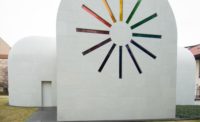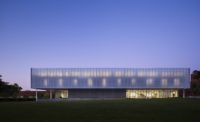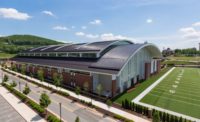Iowa Project Caters to Football Fans
Renovation Shields Kinnick Stadium from Weather, Increases Comfort






Rain, cold and snow are no stranger to fans of the University of Iowa football team. In 2013, for instance, the temperature fell to 18 and degrees wind chill temperatures hit zero as the Hawkeyes played Michigan in the coldest game in the team’s history. In 2015, workers cleared nearly nine inches of snow from Kinnick Stadium after a storm pounded the area for 15 hours.
“There is no manual for this,” athletic director Gary Barta said as crews raced to clean up the stadium, working throughout the evening to prepare for the noon kickoff.
Renovations completed last year at Kinnick Stadium won’t stop snow or rain from falling, or raise the outdoor temperatures. But they will increase comfort for fans with a new hawk-wing-inspired glass façade, concourse, concessions, videoboard and more than 1,600 premium seats. The $89.9 million project included the addition of 17,000 square foot of climate-controlled club seating.
“Our primary goal was to enhance the fan experience at Kinnick Stadium,” Barta said. “These enhancements will keep Kinnick Stadium in the upper echelons of college football stadiums.”
Unique Façade
A key element in improving comfort for fans at Kinnick Stadium is its new ventilated glass cladding. The 655-foot façade, manufactured by Bendheim, wraps around the entire North end zone of the stadium, incorporating more than 14,000 square feet of decorative glass. The custom-glass design, inspired by a hawk wing, features a varied, color-fritted linear pattern and the glass company’s double-shingled cladding system.
There are multiple benefits to the system, particularly in helping improve the game-day experience. The north-facing glass blocks cold northern winds from entering the open areas. It also blocks approximately 90 percent of wind-driven moisture from entering the stadium, while the half-inch panel spacing provides natural ventilation and smoke mitigation.
“The half-inch vertical and horizontal spacing ensured there would be no issues associated with strong vibrations or loud sounds,” added Said Elieh, Director of Technical Design for Bendheim.
Neumann Monson Architects and HNTB developed the final renovation plans. While the college administration strived to improve the comfort of fans, the architects also needed to stay true to the historical integrity of the 1929 building.
“Iowa fans are truly passionate about their stadium. Every design decision was made to improve the fan experience,” said Kim McDonald, Principal at Neumann Monson.
“We wanted to design something light and elegant, to create a modern intervention on the north side of the historic structure. We didn’t want the design to detract from the original 1929 structure,” added Asa Houston, architect at Neumann Monson.
Customized Compression Clips
There were additional benefits to the breathable glass skin. Perhaps the most essential was the use of customized compression clips to clasp the grasp panels, which eliminated the need for drilled holes in the glass. The adjustable, non-traditional point-supported system sped up the installation process and ensured easy future maintenance.
The compression clip system also allowed fabrication of the glass and hardware to begin immediately from the approved shop drawings, rather than requiring time-consuming field measurements.
The clips also allowed installers to avoid issues associated with hardware through the glass, as seen in traditional point-supported spider systems. The project had a tight construction timeline, and the clip system will also allow for speedy future façade maintenance.
Another major benefit to the clip system was the generous amount of flexibility it provided – 1.5 inch tolerance in all directions – which helped speed up fabrication and installation. Installation started towards the end of January 2019 and took approximately two months, an impressive feat for a project encompassing over 14,000 square feet of decorative glass and 6,000 square feet of fiber-cement panels.
“Collaboration at the beginning of the project and the versatile compression fitting system increased installation efficiency by minimizing adjustments in the field through ample tolerances,” said Adam Boeckmann, President of Architectural Wall Systems (AWS), whose team installed the façade.
Additional Aesthetic Appeal
The amount of space needed to accommodate Kinnick’s expansion required cantilevering the concourse approximately 10 feet over the road. The base of the expanded north end zone was then clad in matching brick in a mix of six colors. The two upper stories were clad in decorative glass and fiber-cement panels, installed in the open ventilated façade system by Bendheim.
“One of the reasons we went to new materials is because the north end zone is such a tight footprint to build upon,” architect Houston said. “Architecturally, it’s dishonest to cantilever brick.”
The glass skin delivers a uniform aesthetic across the entire façade. It minimizes the appearance of a mix of transparent and opaque walls. The ultra-clear (low-iron) glass reflects the sky and architectural landscape during the day, while at night the transparent skin reveals views of the illuminated interior.
The glass is imprinted with a wing-inspired, bird-friendly custom fritted glass pattern. The design is a graphic interpretation of a hawk father’s subtle color gradient, with grey Swisspearl fiber-cement panels completing the look at the top. Custom metallic grey powder-coated façade fittings complete the aesthetic.
Taking Pride
University of Iowa is proud of its football history, which includes a Heisman Trophy winner, national championships and 33 appearances in college football bowl games. Kinnick Stadium is ranked among the toughest places to play for visiting teams. “Teams have consistently struggled to come into Iowa City and leave with a win,” Bleacher Report said.
Kinnick is one of the 20 largest university-owned stadiums in the nation. Various renovations have taken place over time, and more are planned for summer. But for now, the completed renovations have further stirred the passion of the Hawkeye football faithful.
“To see this stadium go from a vision three years ago to reality today, it’s been quite a project,” Damian Simcox, the Iowa assistant athletics director of facilities, said in a newspaper interview. “It’s something we can take pride in.”
Looking for a reprint of this article?
From high-res PDFs to custom plaques, order your copy today!









